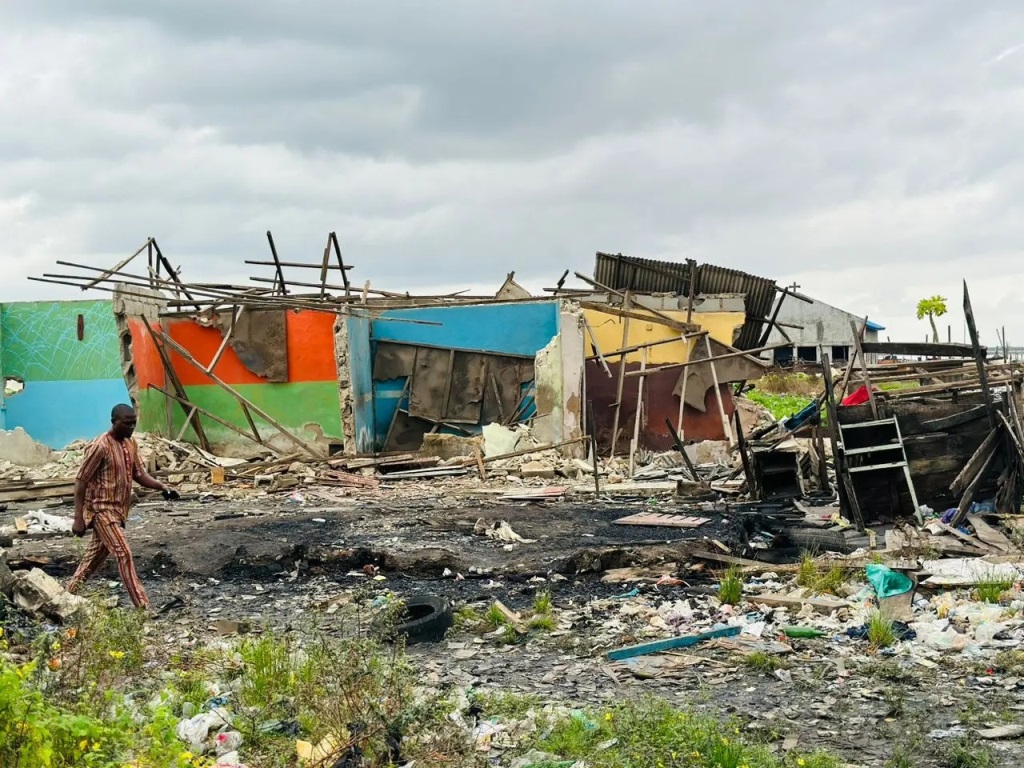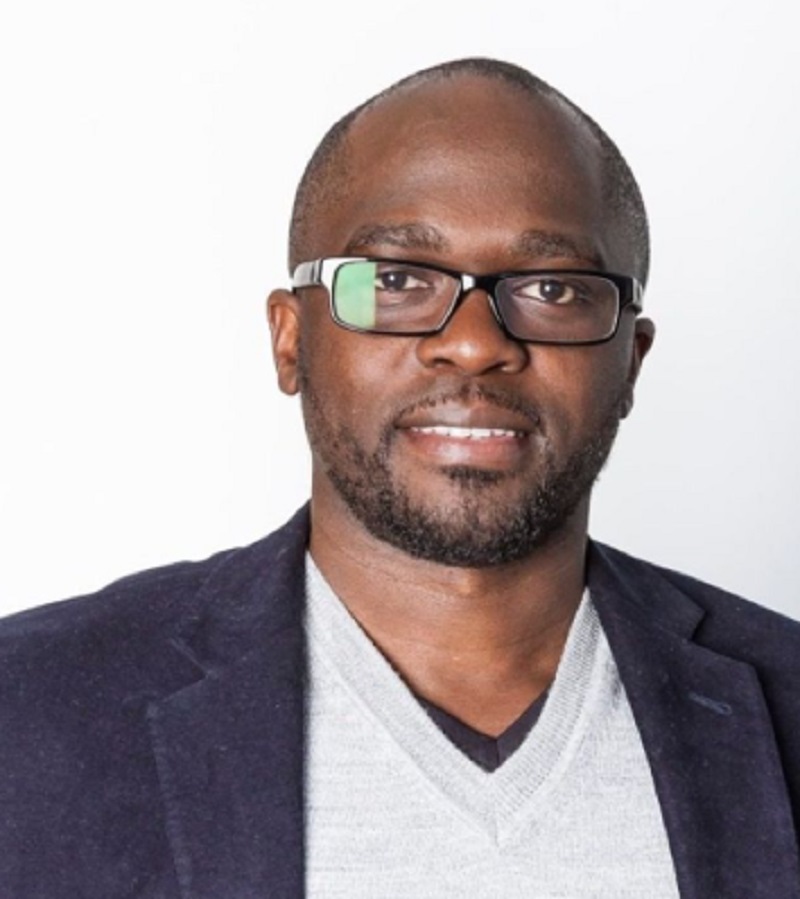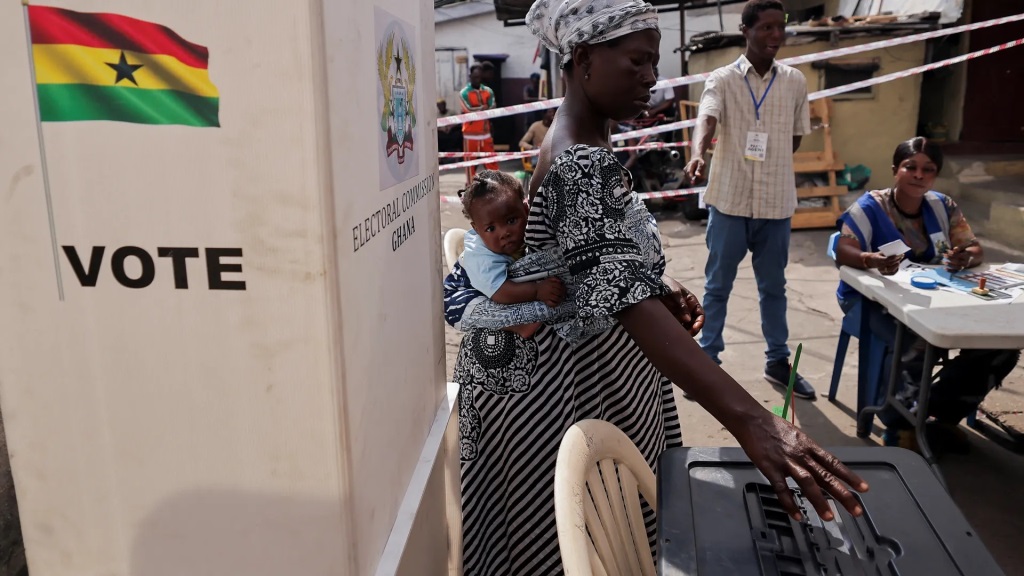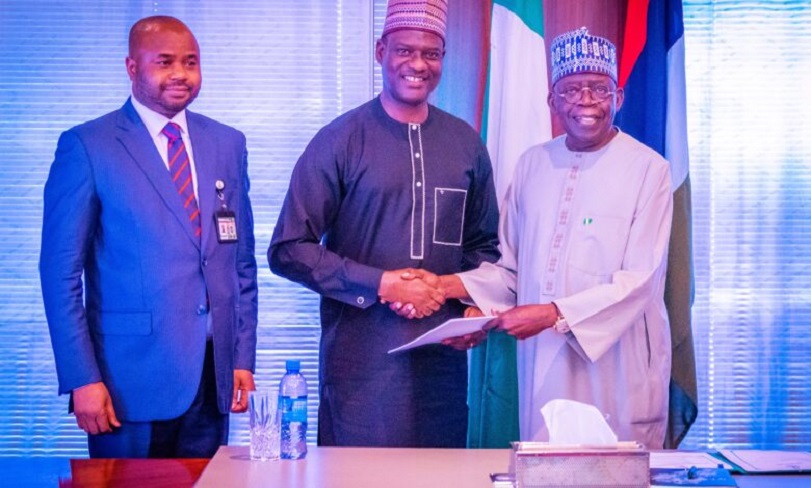Feature/OPED
Forced Evictions and Lagos State Government

By Jerome-Mario Chijioke Utomi
It was in the news recently that residents of the Oworonshoki area in Lagos State on Wednesday, August 2, 2023, protested the ongoing demolition in their area by the Lagos State Task Force, which has seen many residents lose their belongings and homes, left several women and children homeless, and forced many to seek shelter in churches and uncompleted buildings in other areas.
During the protest, which was held at the state House of Assembly complex in Alausa, Ikeja, protesters were seen with placards with inscriptions such as “Say no to land grabbers and wrong demolition”, “Please help us in Oworonshoki “ and “We plead to the government to come to our rescue.”
Even the Lagos State House of Assembly has, a while ago, in a face-saving effort, ordered the State Environmental and Special Offences Enforcement Unit known as Taskforce to stop the demolition and, in its place, set up a five-member ad-hoc committee to investigate the matter and report to the House in two weeks, there are, however, reasons that ring apprehension as to the frequency of this potentially deadly ‘culture’ of demolition/forced eviction in the state and qualify as a reality to worry about, the choice of forced eviction by the state government in its efforts to engineer the development of the state.
Aside from lacking in conventional approaches that infuse human rights principles of participation, accountability, transparency and non-discrimination towards the attainment of equity and justice in such a ‘developmental initiative’, most troubling is the awareness that the present demolition is coming barely two years after a similar thoughtless demolition/forced eviction in July 2021, at the same Oworonshoki was reportedly carried out by the same state government.
Expressly, this piece does not think that what the state government is doing presently in the name of urban renewal/upgrade or regeneration is the best way of turning ‘Slum to Neighbourhood’.
Tragically ‘interesting’ is the awareness that the state has chronically become reputed for achieving urban-related upgrades, renewal and developmental programmes more from a reactionary perspective as against proactive design of effective policies anchored on international best practices.
Take, as an illustration, demolition/forced eviction gained entrance into the state leadership lexicon in July 1990 when Raji Rasaki, in his capacity as Military Governor of Lagos State for yet-to-be-identified reasons, destroyed Maroko. Over 300,000 people that inhabited Maroko then were reportedly affected.
According to reports, Maroko was a sub-city within Lagos. It was peaceful and very popular. The places now called Oniru Royal Estate, some parts of Victoria Island and Lekki Phase 1, were formerly known as Maroko, and it was inhabited by mainly low-income earners. Over 300,000 people inhabited Maroko then. Maroko prided itself on over 150 streets and houses owned by 10,000 landlords. The people were happy people.
Nine years after the Maroko experience, democracy came on board. At each electioneering, intending governors present baskets of manifestos with the promise to make Lagos a more human-friendly, liveable state as the loudest. But contrary to that expectation, documented experience reveals that between 2003 and 2020, demolition/forced evictions of citizens without alternative accommodation characterized every administration in the state.
Beginning with Senator Ahmed Bola Tinubu (May 1999 to 2007, now President of the Federal Republic of Nigeria, to Babatunde Raji Fashola (SAN), 2007 to 2015. From Akinwunmi Ambode (2015 to 2019) and presently Mr Babajide Sanwolu, there was no shift in paradigm as they all stuck to the practice.
The most painful aspect of the narrative is that to achieve this heinous objective; the government has a way of tagging the targeted community as a highly populated urban residential area consisting mostly of closely packed, decrepit housing units in a situation of deteriorated or incomplete infrastructure, inhabited primarily by impoverished persons.
Under the above description/excuse, the following Lagos communities have, between 2003 and 2015, partly or wholly fallen under the bulldozers of the Lagos State Government; Makoko community, Yaba, Ijora East and Ijora Badiya, PURA-NPA Bar Beach, Ikota Housing Estate, Ogudu Ori-Oke, Mosafejo in Oshodi, Agric-Owutu communities, Ageologo-Mile 12, and some communities along Mile 2 Okokomaiko to mention but a few.
As if that was not enough trouble for the poor Lagosians, in 2016, Mr Ambode vowed to evacuate all waterfront shantytowns — a population totalling about 300,000, according to the Nigerian Slum/Informal Settlement Association.
A few months later, 30,000 people lost their homes when one of the slums, Otodo Gbame, a poor fishing community close to the upmarket southeastern district of Lekki, was razed.
During the reported demolition of the Makoko community on July 17, 2012, the British Broadcasting Corporation (BBC) stated that a letter from the Lagos state government was served on residents the previous week, giving them 72 hours to vacate their properties.
The Lagos state authorities further noted in that Letter that the illegal constructions in Makoko constituted an “environmental nuisance, security risk and an impediment to the economic and gainful utilisation of the waterfront” and undermined the “megacity status” of Lagos.
Adding to the woes of the evictees is the government’s ‘love’ for disobeying court directives and non-fulfilment of their promises to resettle those evicted.
As another example, it was reported in the media that at the Supreme Court, Abuja, in the year 2002, the Lagos state government, through the then Lagos State Commissioner for Justice, Professor Yemi Osinbajo, the immediate past Vice President of Nigeria, accepted responsibility for demolishing Maroko community and promised the evictees 1,000 housing units every year, till the whole former house-owners of Maroko are fully resettled.
He admitted that though the government acquired Maroko town in 1972, it again relinquished the acquisition in 1977, thereby confirming that Maroko was not under government acquisition when it was demolished in 1990. But regrettably, to this day, nothing has been done by the state government or its agents to remedy the situation or fulfil the promise made.
The above sad account is an emblem of governments that are unmindful of or deliberately decided to ignore the clarification by the United Nations Independent Expert on the Right to Development, which among other remarks, noted that for a programme to be tagged development, it must require a particular process that allows the realization of economic, social and cultural rights, as well as civil and political rights, and all fundamental freedoms, by expanding the capabilities and choices of the individual.
In a similar vein, the international convention on Economic, Social and Cultural Rights (Ratified by Nigeria in 1993) is one document that probably did more than anything else to capture the gully of disappointments and many sins of successive administrations in the state against the evictees.
It recognized that globally, forced eviction is a brazen violation of the right to life, the right to a fair hearing, the right to dignity of the human person, the right to a private and family life, and the rights to property guaranteed by the constitution of the Federal Republic of Nigeria, and the African charter of Human and peoples’ Right (Ratification and Enforcement Act 1990). Similarly, the United Nations Human Rights Commission Resolutions 1993/77 and 2004/28 affirm that when forced evictions are carried out, they violate a range of internationally recognised human rights.
These include the Human rights to adequate housing, security of the person, security of the home, health, food, water, work/livelihood, education, freedom from cruel, inhuman and degrading treatment, freedom of movement, information, and participation and self-expression.
While it has been reported repeatedly that clearance operations should take place only when conservation arrangements and rehabilitation are not feasible, relocation measures stand made, UN Resolution 2004/28 recognized the provisions on forced evictions contained in the Habitat Agenda of 1996 and recommended that, “All Governments must ensure that any eviction that is otherwise deemed lawful is carried out in a manner that does not violate any of the human rights of those evicted.”
It will be highly rewarding if the state government internalizes these provisions and develops processes or processes that allow the realization of economic and social development of the state in a way that protects the rights of the people.
Broadly speaking, from the above accounts, it is evident that the practice of forced eviction by state actors remains a sad account of or a symbol of, governments that have consciously decided to flagrantly ignore the global framework on physical planning of liveable neighbourhoods, slum upgrade and urban regeneration.
To further buttress this claim, let’s cast a glance at how a ‘famous’ slum challenge was creatively handled in Rio de Janeiro, Brazil, without displacement or eviction of the original occupants.
Instead of removing the favelas, a people initially considered/described as illegal occupants, many of the government’s policies were made to focus more on improving the infrastructure of the people/the area.
The Inter-American Development Bank, for example, funded a $180 million “slum to neighbourhood” project in 1995, which sought to integrate existing favelas into the fabric of the city through infrastructure upgrading and service development.
The project involved 253,000 residents in 73 favela neighbourhoods in Rio de Janeiro. When a favela was selected, a master plan for upgrades was drafted, and community organizations were contacted and asked to provide their input. When the final plan was approved, incentive plans were implemented for hiring construction companies that employed local community workers.
From Brazil to Spain and South Africa, the story and experience are the same.
Comparatively, when one juxtaposes the above accounts as recorded in Brazil with that of July 1990 Maroko’s experience, there exists a gully of difference.
Essentially, aside from the imperative of drawing useful lessons from Brazil’s experience, this piece would also appreciate the Lagos state government explaining whose responsibility it is to provide infrastructures; government or the people/residents?
For me, providing an answer(s) to the above question will redefine as well as address the government’s relationships with the people on issues of physical planning and urban re-generation, usher in eviction-free co-existence while sending new lessons to other states in the country and of course the federal government reputed for practices of forced evictions.
Utomi is the Programme Coordinator (Media and Policy) for Social and Economic Justice Advocacy (SEJA) in Lagos. He can be reached via [email protected]/08032725374
Feature/OPED
The Future of Payments: Key Trends to Watch in 2025

By Luke Kyohere
The global payments landscape is undergoing a rapid transformation. New technologies coupled with the rising demand for seamless, secure, and efficient transactions has spurred on an exciting new era of innovation and growth. With 2025 fast approaching, here are important trends that will shape the future of payments:
1. The rise of real-time payments
Until recently, real-time payments have been used in Africa for cross-border mobile money payments, but less so for traditional payments. We are seeing companies like Mastercard investing in this area, as well as central banks in Africa putting focus on this.
2. Cashless payments will increase
In 2025, we will see the continued acceleration of cashless payments across Africa. B2B payments in particular will also increase. Digital payments began between individuals but are now becoming commonplace for larger corporate transactions.
3. Digital currency will hit mainstream
In the cryptocurrency space, we will see an increase in the use of stablecoins like United States Digital Currency (USDC) and Tether (USDT) which are linked to US dollars. These will come to replace traditional cryptocurrencies as their price point is more stable. This year, many countries will begin preparing for Central Bank Digital Currencies (CBDCs), government-backed digital currencies which use blockchain.
The increased uptake of digital currencies reflects the maturity of distributed ledger technology and improved API availability.
4. Increased government oversight
As adoption of digital currencies will increase, governments will also put more focus into monitoring these flows. In particular, this will centre on companies and banks rather than individuals. The goal of this will be to control and occasionally curb runaway foreign exchange (FX) rates.
5. Business leaders buy into AI technology
In 2025, we will see many business leaders buying into AI through respected providers relying on well-researched platforms and huge data sets. Most companies don’t have the budget to invest in their own research and development in AI, so many are now opting to ‘buy’ into the technology rather than ‘build’ it themselves. Moreover, many businesses are concerned about the risks associated with data ownership and accuracy so buying software is another way to avoid this risk.
6. Continued AI Adoption in Payments
In payments, the proliferation of AI will continue to improve user experience and increase security. To detect fraud, AI is used to track patterns and payment flows in real-time. If unusual activity is detected, the technology can be used to flag or even block payments which may be fraudulent.
When it comes to user experience, we will also see AI being used to improve the interface design of payment platforms. The technology will also increasingly be used for translation for international payment platforms.
7. Rise of Super Apps
To get more from their platforms, mobile network operators are building comprehensive service platforms, integrating multiple payment experiences into a single app. This reflects the shift of many users moving from text-based services to mobile apps. Rather than offering a single service, super apps are packing many other services into a single app. For example, apps which may have previously been used primarily for lending, now have options for saving and paying bills.
8. Business strategy shift
Recent major technological changes will force business leaders to focus on much shorter prediction and reaction cycles. Because the rate of change has been unprecedented in the past year, this will force decision-makers to adapt quickly, be decisive and nimble.
As the payments space evolves, businesses, banks, and governments must continually embrace innovation, collaboration, and prioritise customer needs. These efforts build a more inclusive, secure, and efficient payment system that supports local to global economic growth – enabling true financial inclusion across borders.
Luke Kyohere is the Group Chief Product and Innovation Officer at Onafriq
Feature/OPED
Ghana’s Democratic Triumph: A Call to Action for Nigeria’s 2027 Elections

In a heartfelt statement released today, the Conference of Nigeria Political Parties (CNPP) has extended its warmest congratulations to Ghana’s President-Elect, emphasizing the importance of learning from Ghana’s recent electoral success as Nigeria gears up for its 2027 general elections.
In a statement signed by its Deputy National Publicity Secretary, Comrade James Ezema, the CNPP highlighted the need for Nigeria to reclaim its status as a leader in democratic governance in Africa.
“The recent victory of Ghana’s President-Elect is a testament to the maturity and resilience of Ghana’s democracy,” the CNPP stated. “As we celebrate this achievement, we must reflect on the lessons that Nigeria can learn from our West African neighbour.”
The CNPP’s message underscored the significance of free, fair, and credible elections, a standard that Ghana has set and one that Nigeria has previously achieved under former President Goodluck Jonathan in 2015. “It is high time for Nigeria to reclaim its position as a beacon of democracy in Africa,” the CNPP asserted, calling for a renewed commitment to the electoral process.
Central to CNPP’s message is the insistence that “the will of the people must be supreme in Nigeria’s electoral processes.” The umbrella body of all registered political parties and political associations in Nigeria CNPP emphasized the necessity of an electoral system that genuinely reflects the wishes of the Nigerian populace. “We must strive to create an environment where elections are free from manipulation, violence, and intimidation,” the CNPP urged, calling on the Independent National Electoral Commission (INEC) to take decisive action to ensure the integrity of the electoral process.
The CNPP also expressed concern over premature declarations regarding the 2027 elections, stating, “It is disheartening to note that some individuals are already announcing that there is no vacancy in Aso Rock in 2027. This kind of statement not only undermines the democratic principles that our nation holds dear but also distracts from the pressing need for the current administration to earn the trust of the electorate.”
The CNPP viewed the upcoming elections as a pivotal moment for Nigeria. “The 2027 general elections present a unique opportunity for Nigeria to reclaim its position as a leader in democratic governance in Africa,” it remarked. The body called on all stakeholders — including the executive, legislature, judiciary, the Independent National Electoral Commission (INEC), and civil society organisations — to collaborate in ensuring that elections are transparent, credible, and reflective of the will of the Nigerian people.
As the most populous African country prepares for the 2027 elections, the CNPP urged all Nigerians to remain vigilant and committed to democratic principles. “We must work together to ensure that our elections are free from violence, intimidation, and manipulation,” the statement stated, reaffirming the CNPP’s commitment to promoting a peaceful and credible electoral process.
In conclusion, the CNPP congratulated the President-Elect of Ghana and the Ghanaian people on their remarkable achievements.
“We look forward to learning from their experience and working together to strengthen democracy in our region,” the CNPP concluded.
Feature/OPED
The Need to Promote Equality, Equity and Fairness in Nigeria’s Proposed Tax Reforms

By Kenechukwu Aguolu
The proposed tax reform, involving four tax bills introduced by the Federal Government, has received significant criticism. Notably, it was rejected by the Governors’ Forum but was still forwarded to the National Assembly. Unlike the various bold economic decisions made by this government, concessions will likely need to be made on these tax reforms, which involve legislative amendments and therefore cannot be imposed by the executive. This article highlights the purposes of taxation, the qualities of a good tax system, and some of the implications of the proposed tax reforms.
One of the major purposes of taxation is to generate revenue for the government to finance its activities. A good tax system should raise sufficient revenue for the government to fund its operations, and support economic and infrastructural development. For any country to achieve meaningful progress, its tax-to-GDP ratio should be at least 15%. Currently, Nigeria’s tax-to-GDP ratio is less than 11%. The proposed tax reforms aim to increase this ratio to 18% within the next three years.
A good tax system should also promote income redistribution and equality by implementing progressive tax policies. In line with this, the proposed tax reforms favour low-income earners. For example, individuals earning less than one million naira annually are exempted from personal income tax. Additionally, essential goods and services such as food, accommodation, and transportation, which constitute a significant portion of household consumption for low- and middle-income groups, are to be exempted from VAT.
In addition to equality, a good tax system should ensure equity and fairness, a key area of contention surrounding the proposed reforms. If implemented, the amendments to the Value Added Tax could lead to a significant reduction in the federal allocation for some states; impairing their ability to finance government operations and development projects. The VAT amendments should be holistically revisited to promote fairness and national unity.
The establishment of a single agency to collect government taxes, the Nigeria Revenue Service, could reduce loopholes that have previously resulted in revenue losses, provided proper controls are put in place. It is logically easier to monitor revenue collection by one agency than by multiple agencies. However, this is not a magical solution. With automation, revenue collection can be seamless whether it is managed by one agency or several, as long as monitoring and accountability measures are implemented effectively.
The proposed tax reforms by the Federal Government are well-intentioned. However, all concerns raised by Nigerians should be looked into, and concessions should be made where necessary. Policies are more effective when they are adapted to suit the unique characteristics of a nation, rather than adopted wholesale. A good tax system should aim to raise sufficient revenue, ensure equitable income distribution, and promote equality, equity, and fairness.
-

 Feature/OPED5 years ago
Feature/OPED5 years agoDavos was Different this year
-
Travel/Tourism8 years ago
Lagos Seals Western Lodge Hotel In Ikorodu
-

 Showbiz2 years ago
Showbiz2 years agoEstranged Lover Releases Videos of Empress Njamah Bathing
-

 Banking6 years ago
Banking6 years agoSort Codes of GTBank Branches in Nigeria
-

 Economy2 years ago
Economy2 years agoSubsidy Removal: CNG at N130 Per Litre Cheaper Than Petrol—IPMAN
-

 Banking2 years ago
Banking2 years agoFirst Bank Announces Planned Downtime
-

 Sports2 years ago
Sports2 years agoHighest Paid Nigerian Footballer – How Much Do Nigerian Footballers Earn
-

 Technology4 years ago
Technology4 years agoHow To Link Your MTN, Airtel, Glo, 9mobile Lines to NIN




















